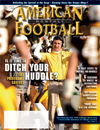Article CategoriesAFM Magazine
|
Drills Report: Pass Protection Medleyby: Roy IstvanAssistant Head Coach & Offensive Line Coach ē University of Rhode Island © More from this issue As you watch your athletes week to week at various positions, itís obvious that certain players can cover ground more rapidly than others during multi-movement assignments. Not only multi-movements but change-of-pace and burst capacity. Some players are capable of these characteristics, but most are not. Recognizing the athletes who have transition speed skills is doable but teaching these skills is even better. Every player on your team can increase their transition speed skills drastically. Technical movement applications is the method that can be taught to every player on the team. As coaches, you would like to see all of your players move rapidly. As a group, it wonít happen naturally. They donít have the physicality or the skill-set to pull it off. It has to be put into your....The full article can only be seen by subscribers.
|
|
|||||||
| HOME |
MAGAZINE |
SUBSCRIBE | ONLINE COLUMNISTS | COACHING VIDEOS |
Copyright 2025, AmericanFootballMonthly.com
All Rights Reserved





